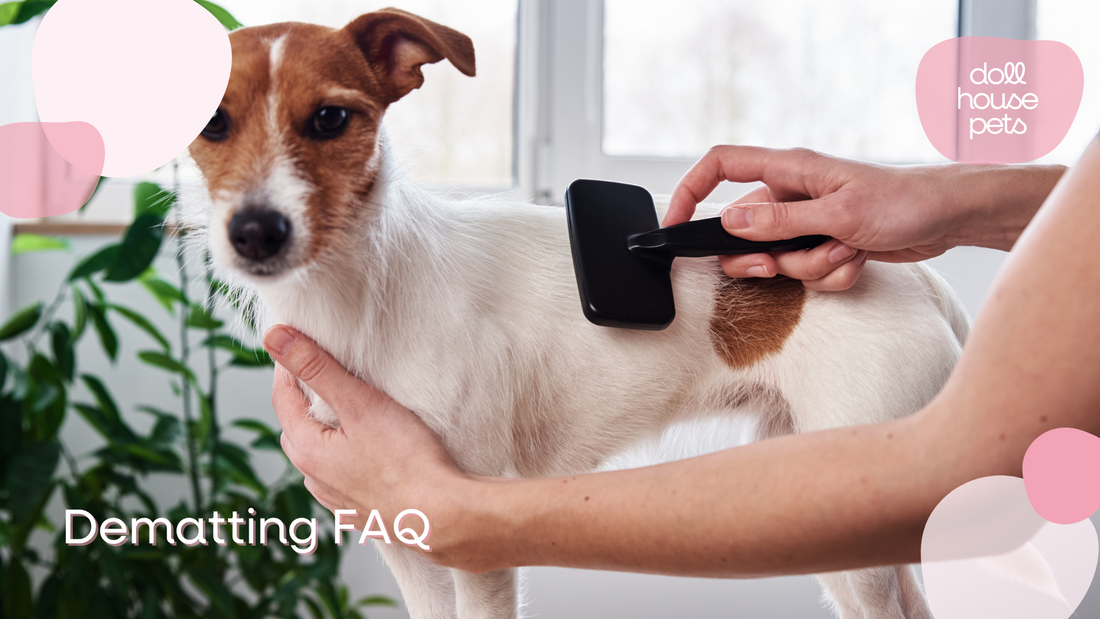
Dematting FAQ: Understanding the Importance and Process
Keeping our furry friends well-groomed is essential for their health and happiness. However, when matts develop in their coat, it can present challenges during grooming sessions. In this blog post, we will address frequently asked questions about dematting, providing insights into why it's necessary, why it takes time, and when alternative grooming methods may be recommended.
Why is dematting expensive?
Dematting can be a time-consuming and intricate process, requiring patience, skill, and specialized tools. Groomers need to work meticulously to avoid causing discomfort or injury to the pet. The cost reflects the expertise, time, and effort invested in safely and effectively removing mats while ensuring the pet's well-being.
Why do you need to remove the matts before cutting my pet's hair?
Matts are tangles of fur that, if left unaddressed, can lead to skin irritation, restricted movement, and even more severe health issues. Attempting to cut hair over the mats without removing them would result in an uneven and unattractive haircut. It is essential to remove the mats first for a cleaner, healthier, and aesthetically pleasing grooming outcome.
Why is it not advised to dematt certain parts, such as the armpit and sanitary area?
Sensitive areas like the armpits and sanitary regions are particularly prone to discomfort or injury during the dematting process. Groomers prioritize the well-being of the pet and may suggest a shave for these areas to ensure a smoother and safer grooming experience.
Why does dematting take up so much time?
Dematting is a meticulous process that requires the groomer's attention to detail. Each matt needs to be carefully untangled or removed, taking into account the pet's comfort. The severity of the matting, the size of the pet, and the coat type can all contribute to the time required for dematting.
How do I prevent my pet from getting matted?
Regular brushing is key to preventing matts from forming. Establish a grooming routine that includes brushing appropriate for your pet's coat type. This will help remove loose hair and prevent tangles from becoming matts. Additionally, professional grooming sessions at regular intervals can help maintain a healthy coat and prevent excessive matting.
Why can't we just cut off the mats or cut over them?
Cutting off matts can be risky as it may cause injury to the pet's skin. Moreover, cutting over the matts without addressing them at the root would result in an uneven haircut. Groomers strive to provide a grooming experience that is both aesthetically pleasing and safe for the pet's well-being.
How does a groomer decide that dematting is not an option and a shave would be better?
Groomers assess several factors to determine the best course of action. These include the severity of matting, the pet's comfort, the risk of injury, and the desired outcome. If the matts are too extensive or if dematting would cause undue stress or discomfort, the groomer may recommend a shave to ensure the pet's safety and well-being.
What are the different kinds of matts on a pet's coat?
Pets can develop various types of matts, including surface matts, which are tangles that form close to the top layer of the coat, and deep matts and spiderweb matts, which occur closer to the skin. Understanding the type of mats on your pet's coat helps groomers determine the appropriate dematting technique.
What are spiderweb matts?
Spiderweb matts are matts that spread out in multiple directions from a central point, resembling a spider's web. They can be particularly challenging to remove and may require extensive dematting or shaving to resolve.
My pet doesn't have clumps of matts, but why does the groomer say my pet is matted?
Even if matts are not visibly clumped together, small tangles or knots can still be present throughout the coat. Groomers are trained to detect and address these hidden matts as they can worsen over time if left unattended. Regular grooming sessions are crucial to prevent such hidden matting.Yes, certain coat types are more prone to matting. Breeds with long, dense, or curly hair, such as Poodles, Bichon Frises, and Yorkies, are more likely to experience matting. However, regular grooming, including brushing and professional maintenance, can help manage and prevent matting regardless of the coat type.
I noticed both an undercoat removal charge and a dematting charge in my bill. What does this mean?
In your grooming bill, you may come across separate charges for undercoat removal and dematting. Let's understand what these terms entail:
Undercoat Removal: Undercoat removal involves the process of removing loose and dead hair from the undercoat of your pet's fur. Many breeds have a dense undercoat that sheds seasonally, and removing this excess hair helps in maintaining a healthy coat. This procedure usually includes thorough brushing, combing, or specialized tools designed to extract the loose hair without causing any discomfort to your pet.
Dematting: Dematting, on the other hand, refers to the process of detangling and removing tightly knotted mats in your pet's fur. Matts occur when hair becomes tangled and forms clumps that are difficult to comb or brush through. Dematting requires skill, patience, and specialized tools to carefully untangle and remove the matts without causing any pain or discomfort to your pet.
Separate charges for undercoat removal and dematting are included in the bill to account for the additional time, effort, and expertise required for these specific grooming procedures. Both processes ensure that your pet's coat remains healthy, free from tangles, and properly maintained. It's important to note that these charges reflect the groomer's dedication to providing the best grooming experience for your pet and ensuring their coat is in optimal condition. If you have any further questions about the charges or the specific grooming procedures, feel free to reach out to the grooming salon for clarification.
Conclusion:
Dematting plays a vital role in maintaining the health and appearance of your pet's coat. By understanding the importance of dematting, the challenges it may present, and the grooming techniques involved, you can work with your groomer to ensure a comfortable and enjoyable grooming experience for your beloved companion.
Remember, regular brushing, professional grooming, and open communication with your groomer are key to preventing and addressing matting effectively.



